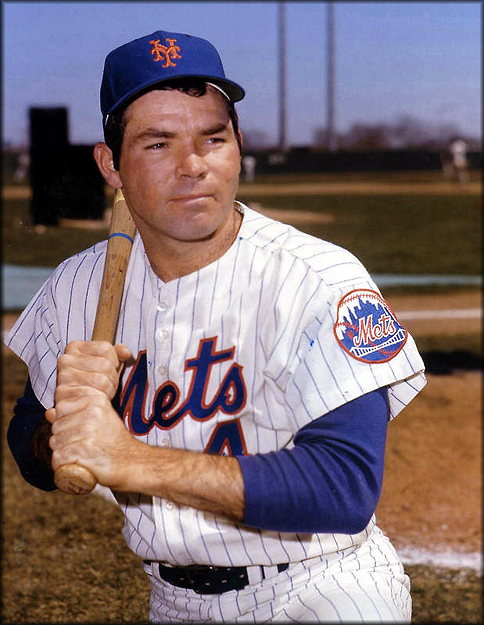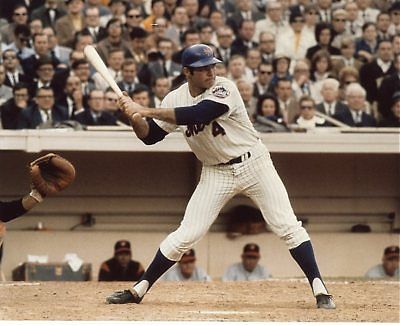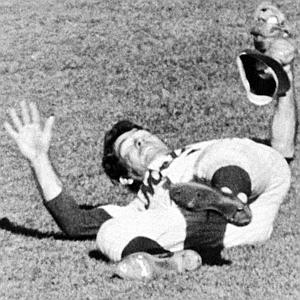 In 1961, President John F. Kennedy challenged America. He insisted that by the end of the decade, we put a man on the moon and return him safely to earth. Kennedy’s idea was outlandish and considered completely and utterly impossible. However, on July 21st, 1969, Neil Armstrong set foot on the surface of the moon. Almost equally as impossible was the Mets winning a World Series. In 1962, the Mets set the modern day record for baseball futility by losing 120 games. The thought of this team winning it all by the end of the decade was also considered completely and utterly impossible. On July 21st, as Apollo astronauts Armstrong and Buzz Aldrin surveyed the lunar landscape, the Mets were 53-39, just 5 games back.
In 1961, President John F. Kennedy challenged America. He insisted that by the end of the decade, we put a man on the moon and return him safely to earth. Kennedy’s idea was outlandish and considered completely and utterly impossible. However, on July 21st, 1969, Neil Armstrong set foot on the surface of the moon. Almost equally as impossible was the Mets winning a World Series. In 1962, the Mets set the modern day record for baseball futility by losing 120 games. The thought of this team winning it all by the end of the decade was also considered completely and utterly impossible. On July 21st, as Apollo astronauts Armstrong and Buzz Aldrin surveyed the lunar landscape, the Mets were 53-39, just 5 games back.
The 69 season was filled with strange plays, unlikely stars and a black cat. As the underdog Mets shocked the baseball world and ran down the Cubs to win the division, fans wondered how long the miracle would last. After outslugging the Braves in the first ever League Championship Series, the Mets faced the mighty Baltimore Orioles. Although many fans hoped the amazin’ season would continue, some were hoping the Mets would at least hold their own and not be too embarrassed by the superior Orioles. Baltimore had won 109 times during the season and captured the ALE by 19 games. The Mets were quickly brought back to reality. On just the 2nd pitch of Game One the Mets were trailing 1-0 after Don Buford took Tom Seaver yard.
The 69 club was sewn from a completely different fabric than their 86 counterparts. Whereas the 86 team was led by solid pitching, big hitters, several all-stars and were heavily favored over Boston, the 69 club was led by a bunch of guys unheard of outside of New York. The Mets won the old fashioned way: Pitching, Defense. And heart.
After losing the opening game 4-1, the Mets captured game 2, 2-1 and returned to Shea tied 1 game each. The Mets won Game 3, 5-0, highlighted by Tommie Agee’s catches and the fact that Gary Gentry out pitched Jim Palmer. Game 4 was next and that would be one for the ages. The right fielder for New York that day was Ron Swoboda.
 Five seasons earlier, on April 12, 1965, 20 year old Swoboda made his ML debut. He hit 2 HR’s in his first 4 AB’s and would go on to hit 19 for the year, a Mets record for rookies at the time. Overly optimistic Mets fans quickly pointed out that was more HR’s than Mickey Mantle had hit in hisrookie season. People also began drawing comparisons between Swoboda and Babe Ruth. After all, BOTH were born in Baltimore.
Five seasons earlier, on April 12, 1965, 20 year old Swoboda made his ML debut. He hit 2 HR’s in his first 4 AB’s and would go on to hit 19 for the year, a Mets record for rookies at the time. Overly optimistic Mets fans quickly pointed out that was more HR’s than Mickey Mantle had hit in hisrookie season. People also began drawing comparisons between Swoboda and Babe Ruth. After all, BOTH were born in Baltimore.
Although well loved, Swoboda would never be destined for greatness. There would be no all-star games in his future and no induction in Cooperstown. He was a mediocre hitter at best. But he played with heart. He was not blessed with blinding speed or natural ability. He had no special gift. But his all out play and the fact that he gave it his all and made the most of his limited talent endeared him to fans. It was once said of Ron, “He’s got the heart of a lion.” Ironically, his greatest weakness was his inept fielding. He would frequently circle under routine fly balls seeming unsure, confused. A pop up to RF was always an adventure and resulted in fans holding their collective breath. Teammates nicknamed him ‘Rocky’ as a tongue in cheek way of chiding him for his lack of defensive prowess.
Swoboda played his part in that miracle season. In Sept, Cardinals ace Steve Carlton set the ML record by striking out 19 batters–But still lost the game, 4-3, thanks to 2 2-run HR’s by Swoboda.
Pivotal game 4 featured Tom Seaver (25-7 and 2.21 ERA) opposing Mike Cuellar (23-11 and a 2.38 ERA). Both would go on to win the Cy Young Award that year. In everything World Series pitching match-ups should be but seldom are, Seaver out pitched Cuellar. With the expression ‘pitch count’ not in anyone’s vocabulary, Seaver went to the top of the 9th clinging to a 1-0 lead. With their backs to the wall, Baltimore battled back. With one out, Frank Robinson and Boog Powell both singled. Baltimore had the tying run on 3rd, the go ahead run on 1st. Future Hall of Famer Brooks Robinson stepped to the plate. He hit Seaver’s first delivery to right-center. The white baseball began sinking against the bright green grass. There was no one in sight.
Suddenly, out of nowhere, the poor fielding Swoboda appeared. Using all of his limited speed, he dove and stuck out his glove. Completely parallel to the grass and fully extended, just inches from the ground, he snared the sinking liner. The initial response was one of disappointment. After all, Frank Robinson scored easily from 3rd on the Sac Fly and Baltimore tied the game. However, seconds later, the reality of Swoboda’s catch began to sink in. Had the ball gotten by him it would have easily rolled to the wall and given the Orioles a 2-1 lead, most likely a victory and guaranteed a return trip to Baltimore. Swoboda’s catch kept the game tied at 1. The Mets would win the game in 10 innings. The next day Jerry Koosman would take the mound for Game 5.

Swoboda’s catch is an iconic image, not only in Mets history but in World Series history. It is considered by many to be one of the best catches, if not the best, in the history of October baseball.
On March 31, 1971, 26 year old Swoboda was sent to Montreal in exchange for Don Hahn. Later that year, he returned to NY but was wearing pinstripes. In 1973, however, as the Mets battled toward their 2nd World Series, the Yankees released Swoboda. He attended spring training in 1974 with the Braves but did not make the team. Although he attempted a brief comeback with the Mets in 76, (he attended spring training but didn’t make the cut), Ron Swoboda decided to retire.
After departing Baseball, Ron worked as a sportscaster for WCBS-TV in NY for several years. He also worked for stations in Milwaukee and Phoenix and for a brief time, was part owner in a short lived restaurant with teammate Ed Kranepool. He is currently working as a color commentator for the New Orleans Zephyrs. He has developed a deep appreciation for New Orleans art and architecture and can frequently be spotted enjoying Jazz Music in New Orleans’ many clubs. His career stats are unimpressive. In 6 years with the Mets, he hit just 242, only collected 536 hits, a poor 319 OBP, 304 RBI’s and ironically, 69 Home Runs. However, when fans remember Swoboda, they don’t pay attention to his stats. His numbers are meaningless to Mets fans. Certain things, like home runs and RBI’s can be measured. Other things, like heart, can not. And that is one area where Swoboda is unsurpassed.
When one looks at the history of the turbulent 1960’s, there are certain images, certain photographs that will always be seen. You will always see a picture of John Kennedy. An image of Bobby Kennedy tousling his hair. Martin Luther King Jr. on the steps of The Lincoln Memorial. You will be sure to see a photo of The Beatles. And Jimmy Hendrix playing a guitar like no one ever had. You can count on seeing a helicopter dropping bombs in the jungles of Viet Nam and the image of Neil Armstrong stepping onto the moon. And also the unforgettable image of Ron Swoboda sliding across the green grass of Shea.














